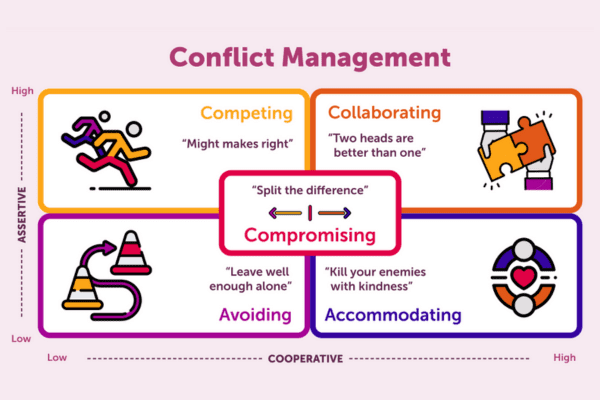Best Practices You Need to Know to Get the Most Out of Your Conflict Management Course
Having trouble with personality clashes and petty disputes at the office? Finding it difficult to have continuous harmony within the team? It happens. Now, do you have a conflict management course available in your organisation?
If not, why not? You are creating unnecessary pressure and barriers for you and your team. This is by not having conflict management training accessible.
Consider the last conflict that occurred in your workplace. Was it resolved successfully? Would the outcome have been better if conflict management training had taken place before the issue? Imagine how different the result would have been if a conflict management course happened.
Conflict at work does take place. No matter how amazing our team is, there will be conflict. It may be something minor or major. And, it needs to be handled effectively. Therefore, conflict management courses are essential. Remember, the training is not just for the leaders, it’s for employees too.
What is Conflict Management Training?

So, what is conflict management training? It is a programme designed to help all members of the organisation to prevent and manage conflict. The programme will contain different approaches to conflict management.
First, you would look at prevention. In all cases, prevention is better than cure. Here, the programme shares steps they can take to prevent conflict from occurring. These steps include:
- Know your own triggers.
- Understand the impact conflict can have.
- Address your emotional responses to situations.
- Identify early signs of possible conflict.
- Encourage open communication within the team in order to avoid conflict.
Next, the programme would instruct on how best to manage conflict when it happens. Once conflict has happened, you need to know how best to handle it. Most programmes will cover the best approaches available to take.
One example is from Kenneth Thomas and Ralph Kilmann. They identified 5 strategies to apply when managing conflict. They depend on the level of cooperation and assertiveness involved. These are avoiding, accommodating, competing, collaborating and compromising.

Let’s explore these strategies in more detail…
#1- Avoiding:
This approach sees the people involved simply ignoring the conflict. No action is taken because the effort is less rewarding than the potential outcome. This can be used for some smaller issues that are not worth the time invested. However, no resolution will be found. And, in some cases, the conflict may escalate in time.
#2- Accommodating:
Here, we see one person giving in to others. They simply accept their will and demands. Some use this strategy to maintain relationships. Also, it can be used to avoid escalating the situation. However, avoid overusing this method as you may seem like a push-over.
#3- Competing:
So, now we see a much more assertive approach with little cooperation. One person is determined to win no matter what. This is great when playing sports. However, it rarely translates well in the workplace.
#4- Collaborating:
This is a great way to achieve mutually agreed solutions. Everyone involved gets to participate and share their input. Here, resolution is much more easily achieved because it is a combined effort.
#5- Compromising:
Here, not everyone will get everything they might want. However, everyone will get something. This is another way to ensure everyone participates. Also, the solutions have something for all involved.
Then, you would be trained on managing the team after conflict resolution has occurred. Remember, even after conflict occurs, you need to get the team back on track, working together. Sometimes, this is easier said than done. You may have achieved an agreed solution. However, some may hold onto the feelings left by the conflict. Our conflict management course will help you address these potential issues. Also, it will give you pointers on how to bring people back together as a group.

What Learners Say About Our Conflict Management Course
“MBM organised our companies annual team away day and delivered a first-class event. Building the schedule around resolving business challenges and conflicts, the content was well-managed and supported by Darren’s insight into high performing teams in customer-facing environments. We were impressed with every aspect of the training, and would not hesitate to recommend MBM.”
Jon Barfoot
Commercial Director, Barfoots of Botley UK
⭐️⭐️⭐️⭐️⭐️
>> Learn More about this training course <<
Why is Conflict Management Training Important?

There are a number of reasons why a conflict management course is important. These include being able to:
- Communicate more effectively to avoid misunderstandings.
- Avoid wasting time on minor disputes.
- Collaborate better through improved interpersonal relationships.
- Identify potential conflict triggers in the team.
- Avoid blaming others which can lead to conflict.
- Respect others in the team even when there are differences of opinion.
- Listen more effectively to the ideas and opinions of others.
Types of Conflict Management Training
We have seen what conflict management training is and why it’s important. Now, we will look at the types of training that are available out there.
1. Classroom Courses
First, you can invest in facilitator-led training sessions. This can be from your in-house trainer or from an external partner. Either way, these sessions can be very fruitful for everyone involved. The benefits of these training sessions are:
- Increased participation from all attendees.
- Opportunities to have group discussions and learn from others.
- Chances to ask the facilitator for clarification on any topics covered.
- Interaction with people from other departments that have different insights and perspectives.
However, classroom courses are not for everyone. Some possible barriers include:
- Participants learn at different speeds, some may be left behind.
- Some participants are more comfortable sharing, therefore, others may not have a voice.
- Practical application may not occur to check for the effectiveness of learning.
- Some companies simply don’t have the money to invest in this type of training.
2. Online Courses
Nowadays, online courses are very popular. Also, they can be easier to make available to employees in terms of time and resources. When looking at online courses, be sure to use reliable sites. Check reviews or ask others for recommendations. Also, ensure you allocate time for the training to happen. Then, make sure you have the necessary resources available, such as computers, laptops, or tablets/iPads. This will encourage your employees to participate more.
With online courses, be sure to do the following:
- Set clear time frames for completion.
- Monitor progress.
- Ask for proof of completion (either a report or certificate).
- Be sure to encourage those participating until completion.
From experience, I feel that online courses need to have these clear guidelines. I had a situation where one of the leaders in our team was given the opportunity to take part in an online course. This was at the expense of the company.
It started well, the participant seemed interested and motivated. However, because the above guidelines had not been set by their leader, they soon lost interest. The employee failed to complete the course and the necessary assessments. Also, the company failed to see the return on its investment as the skills were incomplete. Therefore, the whole endeavour was a waste of time.
I learnt from that mistake moving forward. So, I personally took the lead for all online courses offered in the future. That way, each participant had proper structure and support in place. We then saw much better results.
3. 1-1 Coaching
Here, we see someone within the organisation taking the lead on coaching others in the area of conflict management training. It can be very effective, especially for those who may be less inclined to participate as part of a group. Here are some considerations.
First, select the right person. Identify someone who has a proven track record of managing conflict. Otherwise, have someone take part in a set training course to be able to train others.
Next, identify a proper location for the coaching to take place. This should be somewhere comfortable for those involved. Avoid public spaces that may distract or intimidate participants.
Also, encourage a way to measure the effectiveness of the coaching sessions. You might use practical or written assessments or a combination of both.
Finally, encourage participants to receive a certificate of completion at the end of the coaching journey. This will encourage them to take part in more coaching in the future. Also, it is a great way to recognise effort and participation, as well as successful completion of the topic.
I have personally coached many members of my team through different topics over the years. I find the time invested to be very rewarding. You have quality time with the attendee. Also, you can address the topic specifically to their needs.
A few things I can personally recommend. Be sure to only use coaches who are confident in their areas of expertise. Also, match the coach with the participant carefully. Be sure that they will connect. Then, get feedback from both to check progress. Avoid getting feedback only from the coach, that leaves the story one-sided.
Conflict Management Courses for Leaders

So, now let’s have a look at the real need for conflict management courses for leaders. Our leaders are responsible for handling conflict. Without the proper tools and skills, this will be unsuccessful. Therefore, conflict management training for our leaders cannot be understated in terms of its importance.
Like many skills, conflict management training can enhance our conflict resolution skills. All leaders must be effective in this area. But, what are the main areas that leaders need to gain from conflict management training that will achieve success? Let’s see the main aspects for leaders.
1- Understand Which Approach Will Work Best
In conflict, different styles can and should be used in different situations. Conflict management courses will allow leaders to better identify which approach to take. Some considerations for leaders at this stage include:
- Understand the context of the conflict from all sides.
- Know who is involved and to what extent.
- Be ready to listen before judging the situation.
- Apply the correct approach (avoid, accommodate, compete, collaborate, compromise).
So, we know which approach will work best for that particular situation. Now, we will have a much better chance of finding a resolution.
2- Share the Expected Outcome With All Involved
Before we get started, share with everyone involved what outcome you are expecting. This could be anything from improved communication to continued collaboration. Whatever the outcome, make sure everyone is clear on what is trying to be achieved. Ask questions to check for understanding. Allow others to speak in case there is any confusion.
3- Involve Everyone in the Process
As a leader, you must refrain from showing any type of bias or favouritism. This can lead to even more conflict. Instead, remain neutral when mediating. Also, allow all voices to be heard. This way, nobody will feel slighted or excluded.
4- Aim for a Win-win
Through a collaborative approach, our leaders should always try to aim for a win-win situation. This way nobody will hold onto the conflict moving forward as they will have gained something from the process. You may need to compromise, however, that still includes everyone gaining something from the resolution.
Leaders need to use a variety of different skills and traits while handling conflict. Here are some of them.
- Active listening
- Empathy
- Fairness
- Open-mindedness
- Problem-solving
- Decision-making
- Collaboration
- Effective communication
- Emotional control
- Negotiating
- Patience
All of these skills will be essential to achieve the best results when managing conflict.
Leaders need to understand the possible outcomes that may occur when conflict isn’t handled properly. Some of those negative outcomes can include:
- Delays in tasks and projects.
- Breakdown in communication.
- Decreased collaboration.
- Open hostility within the team.
- Decreased productivity.
- Possible increase in absences and turnover.
- Increased stress and burnout.
Leaders have a responsibility to ensure these negative outcomes are avoided. Therefore, conflict management courses will help make that happen.
Check out further reading on people management skills.
Conflict Management Courses for Employees

Next, we need to see why conflict management courses is important for employees. Leaders need to take the reigns when conflict occurs. However, employees also have a responsibility to manage conflict. Employees need to understand the negative impact conflict can have on the team. Also, they should know how to prevent and manage it once it happens.
Employees need to have the following understanding:
- Not everyone at your workplace needs to be your best friend.
- Minor differences may occur.
- Difficulties will pass with proper understanding and communication.
- Better teamwork leads to a better work environment.
- Results can be achieved as a team when they know how to address potential conflict.
With this understanding, employees can place themselves in more effective positions to address issues and find solutions.
First, be ready to listen to others. Some in the team may have different ideas that make the task effective.
Next, appreciate the roles that others play in the team. Everyone contributes in different ways.
Also, respect the knowledge and skills others bring to the team. You may have the chance to learn something new. Be open to opportunities to grow.
Then, apply these traits in order to contribute to the team dynamic. Help reduce the risk of conflict by taking the necessary steps mentioned.
The Right Approach to This Training Using RESOLVE

So, we have looked at conflict management training courses from a number of aspects. Now, we will look at an effective approach to making the training effective. We will use RESOLVE to ensure conflict management training has a lasting impact.
1- Research
Our first step is to properly research the different options available. We saw earlier in the article the types of conflict management training that are available. Now, we must decide which best suits our needs.
We need to research the following elements.
- Target audience – know who needs the training.
- Financial impact – check what budget is available.
- The delivery – which type of training is better suited to our company.
- Causes of conflicts in the team – look at the types of conflict situations to personalise the content.
- Frequency of conflict in the team – help you decide the urgency of the training.
All of this research will help better tailor your approach. Also, it will enable you to understand the potential outcome you are aiming to achieve as a result of the training.
2- Explain
Our second step is to create buy-in from the participants. Some of your team may be reluctant to take part. They may see it as a criticism of their capabilities. Therefore, we need to properly explain the need for conflict management courses. Also, explain the benefits they can expect from attending the training. That way, you should see better participation and end results.
Without the proper explanation, you may see:
- Lack of motivation to attend.
- Confusion about the purpose of the training
- General lack of interest and commitment.
- Reduced participation during the sessions.
- Negativity towards the trainer or coach.
- Overall reluctance to participate.
Therefore, communicate the training needs and expectations clearly. Ensure everyone involved is on board. Also, sell the expected outcomes as a way forward to better results.
3- Support
From the moment you start explaining, you need to support everyone taking part in conflict management training. It can be a challenging programme to complete, either in person or online. Furthermore, the completion of the course may require participants to dedicate some of their own time.
In this case, offer whatever support is appropriate for the situation. I have found, from my experience, that with support from the leader, the participants are more motivated. Also, they tend to be more committed to the learning experience. Share your own experiences. Let them know what to expect from attending the training. Also, offer assistance for any assignments that might be required for completion of the programme.
4- Observe
Now, the training has ended. It’s time to observe the progress. See how they are handling even small disputes. Check that they are applying what they have learned. This way, you will be able to gauge the effectiveness of the training. Also, you will see how receptive they were to the skills being taught.
Hopefully, you will observe positive improvements in their approach. Also, you should notice a reduction in conflict if the conflict management training has covered prevention as part of the content.
However, you may notice no change or improvement. At this point, you need to address the same with the attendee. I would make the following suggestions that I have used in the past.
- Ask to see the material they covered in the course.
- Review the content.
- Offer opportunities to practice different scenarios with you.
- Continue to communicate your expectations.
Remember, different people learn at different paces. Don’t expect the same results from everyone at the same time. Some people may lack the self-confidence to apply what was taught. By offering additional help where needed, you will surely observe improvements along the way. Even small steps forward show progress.
5- Lead by Example
A great step for those attending the conflict management training is to see it in practice. Therefore, lead by example. Offer opportunities for attendees to sit in on conflict management sessions you are handling so they can see the real practices. When they see the action first-hand, it will probably link the training and practices together in a better way.
6- Value
Next, appreciate the progress that is being made as a result of attending the conflict management course. The attendees need to feel valued for the improvements they are helping to make happen. That way they will be motivated to continue the steps they are taking. This can be done in a private 1-1 or in a team meeting. Remember, recognition and appreciation are great ways to show others that you value their efforts.
7- Evaluate
Finally, take a step back and review all of the steps you have taken from research to value. Evaluate the effectiveness of each step. Review what you might improve on in the future. Also, continue to evaluate the successes you are seeing as a result of the conflict management training.
So, There You Have It…
We have made every effort to show in very clear terms what conflict management training is and why a course is so important. So stop allowing conflict to eat into your valuable time unnecessarily. Instead, invest time, effort, (and money where needed), in making conflict a minor part of your team’s life. Apply what we have shared and you will start seeing the positive results for yourself.




